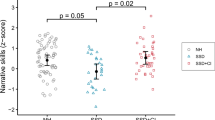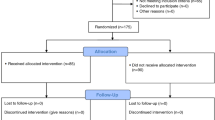Abstract
Objective:
The aim of this study was to determine the expressive vocabulary of children with hearing loss (HL) enrolled in early intervention (EI) ⩽3 vs >3 months in the first 24 months and to compare with hearing controls. It was hypothesized that the number of words produced would be higher for children with HL enrolled in EI ⩽3 vs >3 months.
Study Design:
This is a prospective longitudinal matched cohort study.
Result:
The children with HL produced fewer words than the children with hearing. In addition, children with HL enrolled in EI ⩽3 months had a larger expressive vocabulary percentile score compared with children with HL enrolled >3 months. Children with mild HL enrolled in EI ⩽3 months had the greatest growth in vocabulary between 12 to 16 and 18 to 24 months.
Conclusion:
Although multiple factors are associated with expressive vocabulary growth of children with HL, enrollment in EI ⩽3 months has sustained beneficial effects on expressive vocabulary at 18 to 24 months.
This is a preview of subscription content, access via your institution
Access options
Subscribe to this journal
Receive 12 print issues and online access
$259.00 per year
only $21.58 per issue
Buy this article
- Purchase on Springer Link
- Instant access to full article PDF
Prices may be subject to local taxes which are calculated during checkout

Similar content being viewed by others
References
Yoshinaga-Itano C, Sedey AL, Coulter DK, Mehl AL . Language of early- and later-identified children with hearing loss. Pediatrics 1998; 102 (5): 1161–1171.
Moeller MP . Early intervention and language development in children who are deaf and hard of hearing. Pediatrics 2000; 106 (3): E43.
Yoshinaga-Itano C . Early intervention after universal neonatal hearing screening: impact on outcomes. Ment Retard Dev Disabil Res Rev 2003; 9 (4): 252–266.
Apuzzo ML, Yoshinaga-Itano C . Early identification of infants with significant hearing loss and the Minnesota Child Development Inventory. Sem Hearing 1995; 16: 124–137.
Calderon R . Parental involvement in deaf children's education programs as a predictor of child's language, early reading, and social-emotional development. J Deaf Stud Deaf Educ 2000; 5 (2): 140–155.
White SJ, White REC . The effects of hearing status of the family and age of intervention on receptive and expressive oral language oral skills in hearing-impaired infants. In: Levitt H, McGarr NS, Geffner D (eds). Development of Language and Communication Skills in Hearing-Impaired Children. vol. 26. ASHA Monographs, American Spech-Language-Hearing Association, 1987. pp 9–24.
Vohr B, Jodoin-Krauzyk J, Tucker R, Johnson MJ, Topol D, Ahlgren M . Early language outcomes of early-identified infants with permanent hearing loss at 12 to 16 months of age. Pediatrics 2008; 122 (3): 535–544.
Bess FH, McConnell FE . Audiology, Education and the Hearing Impaired Child. The C.V. Mosby Company: St. Louis, 1981.
Davis JM, Shepard NT, Stelmachowicz PG, Gorga MP . Characteristics of hearing-impaired children in the public schools: part II—psychoeducational data. J Speech Hear Disord 1981; 46 (2): 130–137.
De Villiers PA . Educational implications of deafness: language and literacy. In: Eavey RD, Klein JO (eds). Hearing Loss in Childhood: A Primer. Report of the 102nd Ross Conference on Pediatric Research. Ross Laboratories: Columbus, OH, 1992. pp 127–135.
Holt JA . Stanford achievement test-8th edition reading comprehension subgroup results. American Annals of the Deaf 1993; 128: 172–175.
Bess FH, Tharpe AM . Unilateral hearing impairment in children. Pediatrics 1984; 74 (2): 206–216.
Bess FH, Tharpe AM . Case history data on unilaterally hearing-impaired children. Ear Hear 1986; 7 (1): 14–19.
Bess FH, Tharpe AM, Gibler AM . Auditory performance of children with unilateral sensorineural hearing loss. Ear Hear 1986; 7 (1): 20–26.
Hartvig Jensen J, Johansen PA, Borre S . Unilateral sensorineural hearing loss in children and auditory performance with respect to right/left ear differences. Br J Audiol 1989; 23 (3): 207–213.
Oyler R . Unilateral hearing loss: demographics and educational impact. Lang Speech Hear Serv Sch 1988; 19: 191–210.
Davis A, Reeve K, Hind SB . Children with mild and unilateral hearing loss. A Sound Foundation Through Early Amplification 2001. Proceedings of the Second International Conference. Section V, Chicago, IL, 2001. pp 179–186.
Bess FH, Dodd-Murphy J, Parker RA . Children with minimal sensorineural hearing loss: prevalence, educational performance, and functional status. Ear Hear 1998; 19 (5): 339–353.
Dromi E . Early lexical development. In: Barrett M (ed). The development of language: studies in developmental psychology. Psychology Press: Philadelphia, PA, 1999. pp 99–131.
Fenson L, Dale PS, Reznick JS, Bates E, Thal DJ, Pethick SJ . Variability in early communicative development. Monogr Soc Res Child Dev 1994; 59 (5) (Serial No. 242).
Gregory S, Mogford K (eds.). Early Language Development in Deaf Children. Croom Helm: London, 1981.
Vohr BR, Jodoin-Krauzyk J, Tucker R, Johnson MJ, Topol D, Ahlgren M . Results of newborn screening for hearing loss: effects on the family in the first 2 years of life. Arch Pediatr Adolesc Med 2008; 162 (3): 205–211.
Hollingshead A . Four Factor Index of Social Status. University Press: New Haven, CT, 1975.
Fenson L, Dale PS, Resnick JS, Thal D, Bates E, Hartung JP et al. MacArthur Communicative Development Inventories (CDI). Singular Publishing: San Diego, CA, 1993.
Thal D, Desjardin JL, Eisenberg LS . Validity of the MacArthur-Bates Communicative Development Inventories for measuring language abilities in children with cochlear implants. Am J Speech Lang Pathol 2007; 16 (1): 54–64.
Thal DJ, O’Hanlon L, Clemmons M, Fralin L . Validity of a parent report measure of vocabulary and syntax for preschool children with language impairment. J Speech Lang Hear Res 1999; 42 (2): 482–496.
Bess FH . The minimally hearing-impaired child. Ear Hear 1985; 6 (1): 43–47.
Blair JC, Peterson ME, Viehweg SH . The effects of mild sensorineural hearing loss on academic performance of young school-age children. Volta Rev 1985; 87: 87–93.
Briscoe J, Bishop DV, Norbury CF . Phonological processing, language, and literacy: a comparison of children with mild-to-moderate sensorineural hearing loss and those with specific language impairment. J Child Psychol Psychiatr 2001; 42 (3): 329–340.
Brown J . Examination of grammatical morphemes in the language of hard-of-hearing children. Volta Rev 1984; 86: 229–238.
Davis JM, Elfenbein J, Schum R, Bentler RA . Effects of mild and moderate hearing impairments on language, educational, and psychosocial behavior of children. J Speech Hear Disord 1986; 51 (1): 53–62.
Elfenbein JL, Hardin-Jones MA, Davis JM . Oral communication skills of children who are hard of hearing. J Speech Hear Res 1994; 37 (1): 216–226.
Gilbertson M, Kamhi AG . Novel word learning in children with hearing impairment. J Speech Hear Res 1995; 38 (3): 630–642.
Norbury CF, Bishop DV, Briscoe J . Production of English finite verb morphology: a comparison of SLI and mild-moderate hearing impairment. J Speech Lang Hear Res 2001; 44 (1): 165–178.
Wake M, Poulakis Z . Slight and mild hearing loss in primary school children. J Paediatr Child Health 2004; 40 (1-2): 11–13.
Kiese-Himmel C . Unilateral sensorineural hearing impairment in childhood: analysis of 31 consecutive cases. Int J Audiol 2002; 41 (1): 57–63.
Sedey A, Carpenter K, Brown A . Unilateral hearing loss: what do we know, what should we do?. Presented at: National Symposium on Infant Hearing. 1 August 1 2001. Breckenridge, CO, 2002.
Lederberg AR, Spencer PE . Vocabulary development of deaf and hard of hearing children. In: Clark MD, Marschark M, Karchmer M (eds). Context, Cognition and Deafness. Gallaudet University Press: Washington DC, 2001. p 88112.
Moeller MP, Hoover B, Putman C, Arbataitis K, Bohnenkamp G, Peterson B et al. Vocalizations of infants with hearing loss compared with infants with normal hearing: part II—transition to words. Ear Hear 2007; 28 (5): 628–642.
Mayne AM, Yoshinaga-Itano C, Sedey AL, Carey A . Expressive vocabulary development of infants and toddlers who are deaf or hard of hearing. Volta Rev 2000; 100: 1–28.
Dromi E, Ingber S . Israeli mothers’ expectations from early intervention with their preschool deaf children. J Deaf Stud Deaf Educ 1999; 4 (1): 50–68.
Acknowledgements
We express our appreciation to Joyce Rose for paper preparation, and the families that generously gave their time to participate in this study. This study was funded by a Cooperative Agreement from the Centers for Disease Control & Prevention, # UR3/CCU120033-01 and the Association of University Centers on Disabilities # AUCD-RTOI 2006-06-07-1.
Author information
Authors and Affiliations
Corresponding author
Ethics declarations
Competing interests
The authors declare no conflict of interest.
Rights and permissions
About this article
Cite this article
Vohr, B., Jodoin-Krauzyk, J., Tucker, R. et al. Expressive vocabulary of children with hearing loss in the first 2 years of life: impact of early intervention. J Perinatol 31, 274–280 (2011). https://doi.org/10.1038/jp.2010.110
Received:
Revised:
Accepted:
Published:
Issue Date:
DOI: https://doi.org/10.1038/jp.2010.110
Keywords
This article is cited by
-
Improving early audiological intervention via newborn hearing screening in Belgium
BMC Health Services Research (2018)
-
Newborn hearing screening programme in Belgium: a consensus recommendation on risk factors
BMC Pediatrics (2015)



